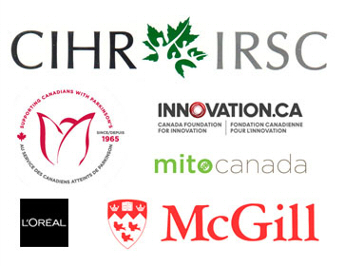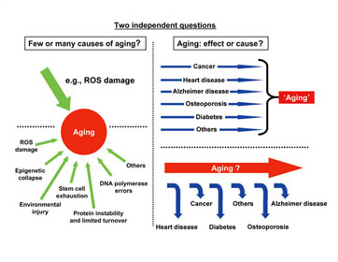Research in the Hekimi Lab
![]() We are using mutants of the microscopic nematode roundworm Caenorhabditis elegans, Saccharomyces cerevisiae, mice, and human cells to study aging, a crucial, profound, and poorly understood biological phenomenon. We hope to obtain insights that will also provide new ways for medical intervention on the aging process. We are particularly focusing on gene activities that affect mitochondrial function, and on mutants that enhance longevity. We are also interested in the biosynthesis and function of ubiquinone (UQ, Coenzyme Q, CoQ), the lipid-like the mitochondrial respiratory chain electron transporter. Here too we use mutants in both organisms to unravel the basic biochemical functions of ubiquinone and to develop drugs that can help alleviate the diseases linked to ubiquinone deficiency.
We are using mutants of the microscopic nematode roundworm Caenorhabditis elegans, Saccharomyces cerevisiae, mice, and human cells to study aging, a crucial, profound, and poorly understood biological phenomenon. We hope to obtain insights that will also provide new ways for medical intervention on the aging process. We are particularly focusing on gene activities that affect mitochondrial function, and on mutants that enhance longevity. We are also interested in the biosynthesis and function of ubiquinone (UQ, Coenzyme Q, CoQ), the lipid-like the mitochondrial respiratory chain electron transporter. Here too we use mutants in both organisms to unravel the basic biochemical functions of ubiquinone and to develop drugs that can help alleviate the diseases linked to ubiquinone deficiency.
Recent Grant Support

2020-2025 CFI (JELF, S. Hekimi)
A path to anti-aging drugs.
2018-2026 CIHR Foundation Grant
ROS metabolism and mitochondrial function in the aging process and in age-dependent diseases.
2015-2020 CIHR operating grant
Molecular mechanisms of pro-longevity signalling.
2015-2016 CIHR/UBC
Canadian Rare Disease Network.
2015-2016 Parkinson’s Society of Canada
A ground-breaking screen for drugs that target mitochondrial dysfunction in Parkinson's disease.
2015-2016 MitoCanada grant in aid
A novel assay to screen for enhanced mitochondrial function.
2014-2019 CIHR operating grant
Controlled ubiquinone biosynthesis.
2011-2015 Res Agreement with L’Oréal
Mechanism of action of resveratrol in the aging process in C. elegans.
2012 McGill Collaborative Research
An Automated Microfluid System (with X. Liu) for High-Throughput, Worm-Based Drug Screening.
2012-2017 CIHR operating grant
Structure, biosynthesis, and function of bile acids in C. elegans.
2011-2013 Centers of Excellence in Neurodegeneration (COEN)
C. elegans models of mitochondrial deficiency in the nervous system.
2011-2016 CIHR operating grant
Mechanisms of longevity in C. elegans mutants with defective mitochondria.
2009-2014 CIHR operating grant
Molecular and physiological mechanisms of longevity in Mclk1+/- mutants.
2010-2014 CFI (Team Leader: P.Lasko)
Mcgill/Ircm Research Group On Embryology And Disease.
2009-2013 CFI (Team Leader: M.Prentki)
Linking Basic, Clinical & Population Health Research to Prevent & Treat Diabetes, Metabolic Syndrome & Complications.
Publications

Parmar G et al. (2024)
Accessory subunit NDUFB4 participates in mitochondrial complex I supercomplex formation. Journal of Biological Chemistry 300(2).
Rebelo A et al. (2023)
Biallelic variants in COQ7 cause distal hereditary motor neuropathy with upper motor neuron signs. Brain 146(10): 4191-4199.
Smith I et al. (2023)
Novel homozyhous variant in COQ7 in siblings with hereditary motor neuropathy. Neurology: Genetics 9(1): e200048.
Branicky R et al. (2022)
Stimulation of RAS-dependent ROS signaling extends longevity by modulating a developmental program of global gene expression. Science Advances 8(48): eadc9851.
Rebelo A et al. (2022)
Biallelic variants in COQ7 leading to coenzyme Q10 deficiency cause charcot-marie-tooth disease. Journal Of The Peripheral Nervous System. S118-S118.
Wang Y, Gumus E, Hekimi S. (2022)
A novel COQ7 mutation causing primarily neuromuscular pathology and its treatment options. Molecular Genetics and Metabolism Reports 31:100877.
Wang Y, Hekimi S. (2022)
The CoQ biosynthetic di-iron carboxylate hydroxylase COQ7 is inhibited by in vivo metalation with manganese but remains function by metalation with cobalt. MicroPubl Biol.
Wang Y, Hekimi S. (2022)
The efficacy of coenzyme Q10 treatment in alleviating the symptoms of primary coenzyme Q10 deficiency: a systematic review. J Cell Mol Med. 26: 4635-4644.
Wang Y, Hekimi S. (2021)Minimal mitochondrial respiration is required to prevent cell death by inhibition of mTOR signaling in CoQ-deficient cells. Cell Death Discov. 7(1):201.
Rossmann M et al. (2021)
Cell-specific transcriptional control of mitochondrial metabolism by TIF1γ drives erythropoiesis. Science. 372(6543):716-721.
Invited Reviews

Wang Y, Lilienfeldt N, Hekimi S. (2024)
Understanding Coenzyme Q. Physiological Reviews 104(4): 1533-1610.
Haynes CM, Hekimi S. (2022)
Mitochondrial dysfunction, aging, and the mitochondrial unfolded protein response in
Caenorhabditis elegans. Genetics.
Wang Y, Hekimi S (2019)
The complexity of making ubiquinone.Trends in Endocrinology and Metabolism, 30(12):929-943.
Wang Y, Branicky R, Noë A, Hekimi S (2018)
Superoxide dismutases: dual roles in controlling ROS damage and regulating ROS signaling. J. Cell Biology, doi: 10.1083/jcb.201708007.
Hekimi S, Wang Y, Noe A (2016)
Mitochondrial ROS and the effectors of the intrinsic apoptotic pathway in aging cells: the discerning killers. Frontiers in Genetics. doi: 10.3389/fgene.2016.0016.
Ying Wang and Siegfried Hekimi (2016)
"Understanding Ubiquinone" Trends Cell Biol. 2016 Jan 27. pii: S0962-8924(16)00003-9.
Wang Y and Hekimi S (2015)
Mitochondrial dysfunction and longevity in animals: Untangling the knot Science 4 December 2015: 350 (6265), 1204-1207.
Hekimi S (2013)
Enhanced immunity in slowly-aging mutant mice with high mitochondrial oxidative stress. OncoImmunology, Apr 1;2(4):e23793.
Wang Y, Hekimi S (2012)
Molecular genetics of ubiquinone biosynthesis in animals. Critical Reviews in Biochemistry and Molecular Biology, 48:69-88.
Liu J-L, Hekimi S (2012)
The impact of mitochondrial oxidative stress on bile acid- like molecules in C. elegans provides a new perspective on human metabolic diseases. Worm, in Press.
Hekimi S, Lapointe J, Yang W (2011)
Taking a ‘Good’ Look at ROS in the Aging Process. Trends in Cell Biology, (10):569-76.
Van Raamsdonk, Hekimi S (2010)
Reactive Oxygen Species and Aging in Caenorhabditis elegans: Causal or Casual Relationship? Antioxidants & Redox Signalling, 13(12):1911-53.